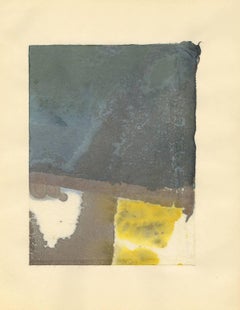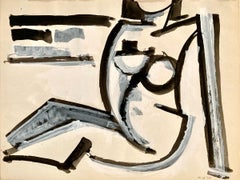Lee Hall Art
to
1
Overall Width
to
Overall Height
to
1
1
1
1
1
1
1
9,388
2,689
1,367
1,353
1
Artist: Lee Hall
Connecticut Summer Fragments
By Lee Hall
Located in New York, NY
Lee Hall (1934-), Connecticut Summer Fragments, a portfolio of watercolor, 29 in all, each about 5 ¼ x 7 ¼ inches, on hand made paper attached to a backing, i...
Category
1970s American Modern Lee Hall Art
Materials
Watercolor
Related Items
Rainstorm Sunset
By Robert Noel Blair
Located in Buffalo, NY
You are viewing a modernist American watercolor painting by Robert Noel Blair.
Robert Noel Blair (American, 1912-2003) was an American artist, painter, sculptor, printmaker and te...
Category
American Modern Lee Hall Art
Materials
Paper, Watercolor
Clinton Hill, (Nude #5), 1951, drawing, figure/abstraction
By Clinton Hill
Located in New York, NY
Clinton Hill (1922-2003), created quintessential mid-century images, but figures are unusual in his work. This is from a very early period. From 1949 to 1951 Hill attended the Brookl...
Category
Mid-20th Century American Modern Lee Hall Art
Materials
Gouache
The Sketch Class, Figurative Study Line Drawing
By David Rosen (b.1912)
Located in Soquel, CA
Expressive line drawing figure study featuring a group of figures in a classroom by David Rosen (Canadian, 1912-2004). Unsigned, but was acquire...
Category
Late 20th Century American Modern Lee Hall Art
Materials
Paper, Pen, Watercolor
$680 Sale Price
20% Off
H 12 in W 8 in D 0.25 in
Abstract Work on Paper Mid-Century Modernism Greek American Gouache Drawing
By Jean Xceron
Located in New York, NY
Abstract Work on Paper Mid-Century Modernism Greek American Gouache Drawing.
A modernist artist who emigrated to America from Greece in 1904, when he was fourteen years old, Jean Xceron is described as having a reputation as an artist that has mysteriously fallen into obscurity---especially since he was reportedly quite prominent during his lifetime. However, a partial explanation of that omission is the fact that many of his papers and early records have been lost. He was a painter of biomorphic abstractions and did collages, which were influenced by Dadaism.
Xceron was active in New York City when modernism was gaining influence. Of him during this period, it was written that his artistic role was "a vital link between what is commonly termed as the first-generation (the Stieglitz group, the Synchromists, etc.) and second-generation, the American Abstract Artists, the Transcendental Painting...
Category
1940s American Modern Lee Hall Art
Materials
Paper, Gouache
$6,000
H 24 in W 20 in D 2 in
Golf Bags, Caddy with Golf Bag on His Back
By Frederick Conway
Located in Missouri, MO
Framed Size: approx 17 3/4 x 20 3/4 inches
Fred Conway (1900-1973)
"Golf Bags, Caddy with Golf Bag on His Back"
Pen/Ink/Watercolor on Paper
Site Size: approx. 10 x 13 inches
Framed Size: approx. 17 3/4 x 20 3/4 inches
A member of the faculty of the Washington University Art School from 1929 to 1970, Frederick Conway...
Category
1960s American Modern Lee Hall Art
Materials
Paper, Ink, Watercolor, Pen
"NY Street Signs" Mid-20th Century WPA 1938 Modernist Abstract Realism Pop Art
By Stuart Davis
Located in New York, NY
"NY Street Signs" Mid-20th Century WPA 1938 Modernist Abstract Realism Pop Art
Stuart Davis (American, 1892-1964) "Street Signs" Modernist gouache and traces of pencil on paper in the proto-pop art style Davis is celebrated for, 1938, signed to lower right, framed. Image: 11 1/4 x 15 1/4 inches. Frame by Bark: 18 1/2 x 22 inches.
LITERATURE: A, Boyajian, M. Rutkowski, Stuart Davis, A Catalogue Raisonne, Vol. 2, New Haven, Connecticut, 2007, vol. II, p. 632, no. 1232, illustrated.
EXHIBITIONS: ACA Galleries, New York American Artists' Congress: Group Exhibition of Paintings and Sculpture, Dec. 3-16, 1939 (SDAB I, 12/3/39, p. 129). Outlines Gallery, Pittsburgh, Stuart Davis, Mar. 3-16, 1946. Coleman Art Gallery, Philadelphia, 5 Prodigal Sons: Former Philadelphia Artists: Ralston Crawford, Stuart Davis, Charles Demuth, Julian Levi, Charles Sheeler, Oct 4 - 30, 1947 (pamphlet), no. 12.
PROVENANCE: The artist; Mr. and Mrs. Frank Bowles, New York, Apr. 3, 1956; thence by descent, Private Collection, New York.
NOTES: According to the Catalogue Raissonne, "the title 'Street Signs' is recorded in the artist's account books...
Category
1930s American Modern Lee Hall Art
Materials
Paper, Gouache, Pencil
$125,000
H 18.5 in W 22 in D 1 in
"Through the Trees" Watercolor Mid-20th Century Modern Excellent Provenance
By Arthur Dove
Located in New York, NY
"Through the Trees" Watercolor Mid-20th Century Modern Excellent Provenance
Arthur Dove (1880-1946)
"Through the Trees"
5 x 7
Watercolor on paper, 1938
Singed lower center
Framed: 1...
Category
1930s American Modern Lee Hall Art
Materials
Paper, Watercolor
Modern Tropical Abstract -- "Spires II"
Located in Soquel, CA
Colorful abstract watercolor of imaginative shapes in a tropical setting with botanical landscape elements by Claire Wolf Krantz (American, b. 1938). Signed "Claire Wolf Krantz" lower right. Titled "Spires" lower center. Dated "11/18/77" and numbered "II" in a series lower left. Peach colored mat and bronze tone metal frame. Image, 14"H x 14"L.
Kranz is an artist and art critic living in Chicago, she uses fictional and real elements in her works. She is known for mixed media works layering photograph...
Category
1970s American Modern Lee Hall Art
Materials
Paper, Watercolor
$476 Sale Price
20% Off
H 22 in W 21 in D 1 in
Italy Goes to War
By Arthur Dove
Located in Bryn Mawr, PA
Provenance
An American Place, New York;
World House Galleries, New York, 1953;
Private collection, New York;
Betty Krulik Fine Art, 2007;
Avery Galleries until present
Exhibitions
An American Place, New York, Exhibition of New Arthur G. Dove Paintings...
Category
1940s American Modern Lee Hall Art
Materials
Paper, Watercolor
Abstract Landscape
By Wes Olmsted
Located in Buffalo, NY
An original watercolor painting by American artist Wes Olmsted depicting an abstract landscape view.
Category
1960s American Modern Lee Hall Art
Materials
Archival Paper, Watercolor
"Barns" Watercolor Mid-20th Century Modern Abstract Realism Excellent Provenance
By Arthur Dove
Located in New York, NY
"Barns" Watercolor Mid-20th Century Modern Abstract Realism Excellent Provenance
Arthur Dove (1880-1946)
"Barns"
5 x 7 inches
Watercolor on paper, 19...
Category
1940s American Modern Lee Hall Art
Materials
Paper, Watercolor
Clinton Hill, Paris, July, 1951 (France), mid-century abstract gouache drawing
By Clinton Hill
Located in New York, NY
Clinton Hill (1922-2003), created quintessential mid-century images.
He lived in SoHo, New York, and was a frequent Gallery visitor.
Born in Idaho and raised on a working ranch, ...
Category
Mid-20th Century American Modern Lee Hall Art
Materials
Gouache
$1,500
H 10.88 in W 8.13 in
Lee Hall art for sale on 1stDibs.
Find a wide variety of authentic Lee Hall art available for sale on 1stDibs. You can also browse by medium to find art by Lee Hall in paint, watercolor and more. Much of the original work by this artist or collective was created during the 1970s and is mostly associated with the modern style. Not every interior allows for large Lee Hall art, so small editions measuring 8 inches across are available. Customers who are interested in this artist might also find the work of Winold Reiss, Abraham Walkowitz, and Leon Kelly. Lee Hall art prices can differ depending upon medium, time period and other attributes. On 1stDibs, the price for these items starts at $7,500 and tops out at $7,500, while the average work can sell for $7,500.

